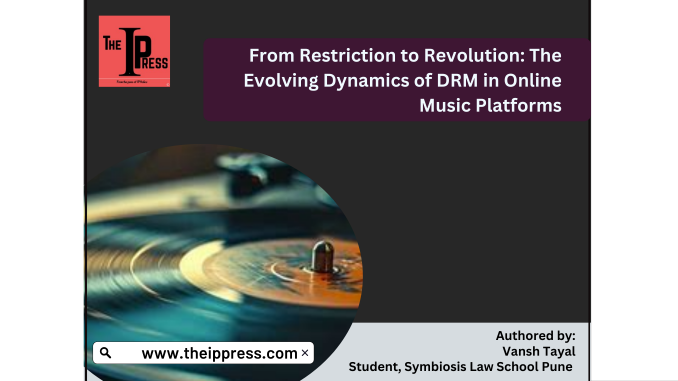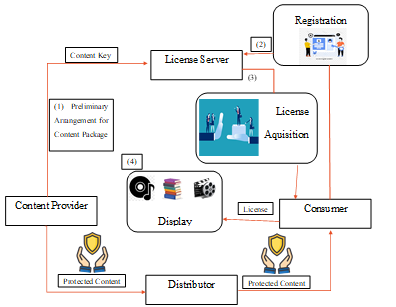
Introduction
Digital files cannot be made uncopiable, any more than water can be made not wet
~ Bruce Schneier,
Cryptographer and Computer Security Specialist
The observation made by Brune Scheiner captures the point that protecting digital content is inherently challenging in an era of ubiquitous file-sharing and seamless reproduction. In that regard, the advent of DRM can be traced back to the 1960s when the early approach by Electronic Publishing Resources, Inc. laid down the foundation of DRM. DRM systems were developed to legitimately restrict unauthorized duplication and uses that would infringe upon the legal safeguards provided to copyright holders. It was further meant to grant publishers increased authority over the distribution and utilization of their works. However, DRM has consistently faced criticism for its perceived infringement of copyright legislation, imposition of excessive control beyond the safeguards provided by copyright law, and obstruction of user rights as legally recognized. This control over content access creates tensions between DRM and fair use provisions under copyright law, which allow limited use of copyrighted material. Moreover, when the concept “the answer to the machine is the machine” was proposed in 1995, it did not anticipate this level of access control, DRM technologies have shifted focus from restricting specific uses of copyrighted content to controlling access.
In online music distribution, DRM systems are under even greater scrutiny; their overly protective control sometimes undermines proper usage and erects barriers for self-promoting musicians. As part of the streaming services, regional restrictions are also added to encryption methods, interfering with the user’s interest in accessing the content. Bureaucratic controls of the material shared through content stifle flexibility in artistic discovery and growth. Section 65A of the Indian Copyright Act criminalizes the circumvention of DRM. On the other hand, it has been argued that such protections go too far in limiting legitimate and valuable uses such as educational projects, research, and artistic collaboration. Consequently, independent artists cannot be visible, and music users lose the music they legally possess because of the settings used to share those files.
This blog discusses the effect of DRM systems on the socioeconomic status of independent musicians, explains how current frameworks undermine users’ rights, and examines how future technologies, like blockchain, may offer more flexible and equitable DRM models. It further sketches the trajectory of a DRM system balancing copyright protection with consumer rights in the interest of both creators and consumers.
Critical Analysis
In the case of online music, it is argued that DRM systems were designed to control the distribution and use of digital content to combat unauthorized sharing and piracy. However, they have faced perennial criticism due to their restrictive measures and adverse effects on user rights, fair use, and innovation. Recent studies reveal that although DRM seeks to protect intellectual property, its inflexible frameworks often conflict with user needs and emerging trends in music consumption. The traditional DRM mechanisms are too restrictive, particularly when sharing and discovering music, which in turn reduce accessibility and create barriers to user-friendly consumption.
The relationship between DRM and copyright is typically viewed through traditional copyright laws. Despite the best efforts to protect every creator’s brainchild, the existing legal frameworks fail to address how evolving digital content legislation impacts online music platforms and user rights. For example, stringent DRM controls can impede legal use in educational and research settings. While the issues are acknowledged, proposed solutions frequently remain theoretical, lacking realistic frameworks that combine protection with the flexibility required for fair use.
Moreover, when viewed from a different angle, DRM can be linked to the shifts in revenue streams across the music industry. While DRM permits copyright holders to control digital content access and usage, It would not be a stretch to say that DRM has a potentially “detrimental effect on the music industry” because its stringent content controls limit distribution channels. In traditional models, revenue depended on direct sales through C.D.s and other physical formats, but digital transformation requires more flexible and shareable strategies to adapt to new consumption patterns. DRM inherently limits revenue for artists, particularly independent musicians, who rely on sharing for exposure and income.
In line with this, DRM inadvertently overlooks this group by imposing a “pay-per-use” model contrary to their needs, restricting how creators and listeners connect. Furthermore, the erosion of the “fair use” principle further impacts independent musicians’ ability to build upon existing works and collaborate. Additionally, it gravely overlooks the impact on independent artists relying on flexible sharing strategies for higher exposure and income, making it crucial to remold the rigid DRM frameworks to lessen the detrimental effects on the music industry.
The DRM implementation has resulted in adverse economic effects, like “raising barriers to entry” and “exacerbating existing market failures.” While aiming at reducing piracy, using DRM may harm social welfare by reinforcing monopoly pricing and limiting positive external factors, like exposure, for independent artists.
Changes in India’s copyright law, including DRM provisions, were intended to balance protection between the creators and the consumers. On the contrary, these amendments inadequately addressed how DRM can lead to inequities, particularly for smaller artists and composers. It tends to restrict access to content, directly affecting independent artists who depend on flexible sharing strategies for visibility and income.
Current DRM systems offer several implementation layers at the application, operating system, and hardware levels. However, they criticize existing systems for being non-interoperable and often failing to fully satisfy customers or rights holders. For instance, Apple’s iTunes Music Store and Microsoft’s Rights Management System (RMS) are examples of DRM implementations that attempt to balance user-friendliness and security but may lack the flexibility needed to support sharing strategies vital for independent artists.
The blog highlights that DRM requires a complete redesign to encourage creativity, as current solutions frequently protect huge media companies at the expense of smaller artists. DRM should prevent piracy while allowing for flexible distribution and advertising. Emerging technologies like blockchain that improve security and user rights remain underexplored. Adopting these developments is critical to developing adaptive and successful DRM approaches. Future DRM systems should integrate new technology, give transparency, and adhere to fair use principles to strike a compromise between solid protection for rights holders and changing consumer needs.
Recommendations
Implement Blockchain in the Distribution Process for Transactions that are Fair and Transparent Blockchain technology can revolutionize the music industry by ensuring precise, direct royalty distribution between artists and consumers. The existing DRM systems are plagued with challenges of interoperability and transparency. Blockchain-based smart contracts would significantly enhance the ability of artists to garner the proper royalties, even without an intermediary, with such assurance that the intended creators receive their share.
Adopt Adaptive DRM Models for Flexible Access
Classic DRM models are overly restrictive, particularly for independent artists who rely on sharing models for exposure to their work. Flexible DRM systems significantly reduce the complexity involved in allowing user access. Along this line, an adaptable DRM scheme should be premised on fair-use access for education and research, based on the accommodation of regional differences, and on the promotion of cross-platform compatibility to enhance user-friendly consumption.
To achieve that goal, the author designed a sample DRM system to control access to digital content. (refer to Image 1)

Image 1
This proposed DRM, therefore, is regarded as providing a better and more personalized system for content protection. Incorporating user authentication, which may include biometric data, ensures that only the pre-registered users are issued with licenses, granting them access to the encrypted contents. The ability of the license server to maintain tight control of the encryption keys thus eliminates sharing risks and threats. Moreover, the preemptive structuring of the content package forms a strong link between the content provider and the distributor so that protected content is safely transferred from production to consumption. The model reduces piracy and offers a more user-centric licensing model that eases the acquisition and use of digital media.
Revise Legal Frameworks to Better Protect Fair Use and Independent Artists
For example, current legal regimes like Section 65A of the Indian Copyright Act criminalize the circumvention of DRM, but in doing so, they often go too far. India should be guided by the fair dealing principle when framing any DRM law. Independent artists should retain control of their created works and get fair compensation, and the exception that should be made must be differentiated and classed as fair use.
Conclusion
The introduction of the DRM (Digital Rights Management) systems for the protection of intellectual property in the burgeoning digital world has come with severe condemnation regarding its very nature that cripples online music distribution. Among the many criticisms, the majority falls on its restrictive nature, particularly on fair use, consumer rights, and exposure for independent artists. The sociological outcomes are such that the DRM schemes shape, to a greater or lesser extent, not only the revenue streams and visibility of independent musicians but also the broader framework of user access and flexibility in music consumption. Although DRM is still very relevant in protecting the rights of content owners and the fight against piracy, its rigorous control often contradicts the new tendencies in music consumption and becomes a brake on the creative activity of independent musicians.
Future frameworks have to get this balancing act right, between protecting the rights of the holders and consumers and allowing the necessary flexibility to the trends and technologies that would arise, like blockchain. Current research makes an effort to argue that the only possible way for the industry to align its goals with modern expectations and the inevitable digital environment will be by adopting a more inclusive, fair, and flexible DRM system.
Author: Vansh Tayal
Vansh Tayal is a fourth-year law student at Symbiosis Law School, Pune, specializing in Intellectual Property Law. He has interned with renowned firms like K&S Partners and Intepat IP Services, gaining hands-on experience in trademark opposition, IP drafting, and legal research. Vansh has also published articles in esteemed legal journals and participated in various moot court competitions. He also holds certifications from international institutions, showcasing his strong academic and practical legal expertise.

Leave a Reply